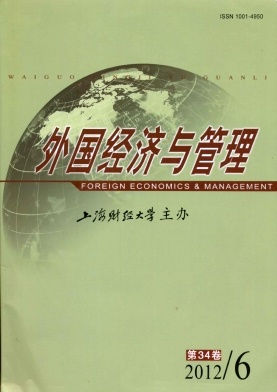架构理论研究脉络梳理与未来展望
外国经济与管理 2012 年 第 34 卷第 06 期, 页码:74 - 81
摘要
参考文献
摘要
架构理论(architecture theory)对于理解、设计和管理产品、组织、产业等复杂系统具有重要的价值,并开始引起战略管理学界的关注。本文在文献梳理的基础上力图理清架构理论的研究脉络,解析架构的内涵,通过探究产品、组织和产业层次的产品架构、组织架构、知识架构、价值创造架构、产业架构等视角研究的核心概念与重点来评介现有的架构理论研究成果,并构建了一个多层次架构理论研究框架,最后对架构创新和跨层次理论研究进行了简要展望。
[1]Agarwal R,et al.Spillovers across organizational architec-tures:The role of prior resource allocation and communication in post-acquisition coordination outcomes[J].Strategic Mana-gement Journal,2012,33(6):710-733.
[2]Baldwin C and Clark K.Managing in an age of modularity[J].Harvard Business Review,1997,75(5):84-93.
[3]Boumgarden P,et al.Sailing into the wind:Exploring the rela-tionships among ambidexterity,vacillation,and organizational performance[J].Strategic Management Journal,2012,33(6):587-610.
[4]Brusoni S,et al.Knowledge specialization,organizational cou-pling,and the boundaries of the firm:Why do firms know more than they make?[J].Administrative Science Quarterly,2001,46(4):597-621.
[5]Campagnolo D and Camuffo A.The concept of modularity in management studies:A literature review[J].International Journal of Management Reviews,2010,12(3):259-283.
[6]Christensen C M,et al.Disruption,disintegration and the dis-sipation of differentiability[J].Industrial and Corporate Change,2002,11(5):955-993.
[7]Dietl H,et al.Value creation architectures and competitive ad-vantage:Lessons from the European automobile industry[J].California Management Review,2009,51(3):24-48.
[8]Eom J.Modularity and technological change:A primer and synthesis[J].Asian Journal of Technology Innovation,2008,16(2):1-24.
[9]Ethiraj S and Levinthal D.Bounded rationality and the search for organizational architecture:An evolutionary perspective on the design of organizations and their evolvability[J].Adminis-trative Science Quarterly,2004,49(3):404-437.
[10]Fixson S.Product architecture assessment:A tool to link product,process,and supply chain design decisions[J].Jour-nal of Operations Management,2005,23(3/4):345-369.
[11]Fixson S and Park J.The power of integrality:Linkages be-tween product architecture,innovation,and industry struc-ture[J].Research Policy,2008,37(8):1296-1316.
[12]Galvin P and Morkel A.The effect of product modularity on industry structure:The case of the world bicycle industry[J].Industry and Innovation,2001,8(1):31-48.
[13]Gokpinar B,et al.The impact of misalignment of organiza-tional structure and product architecture on quality in com-plex product development[J].Management Science,2010,56(3):468-484.
[14]Hannan M,et al.Cascading organizational change[J].Organi-zation Science,2003,14(5):463-482.
[15]Hoetker G.Do modular products lead to modular organizations?[J].Strategic Management Journal,2006,27(6):501-518.
[16]Jacobides M,et al.Benefiting from innovation:Value crea-tion,value appropriation and the role of industry architec-tures[J].Research Policy,2006,35(8):1200-1221.
[17]Jacobides M and Winter S.The co-evolution of capabilities and transaction costs:Explaining the institutional structure of production[J].Strategic Management Journal,2005,26(5):395-413.
[18]Jacobides M G and Billinger S.Designing the boundaries of the firm:From“make,buy,or ally”to the dynamic benefits of vertical architecture[J].Organization Science,2006,17(2):249-261.
[19]Karim S and Williams C.Structural knowledge:How execu-tive experience with structural composition affects intrafirm mobility and unit reconfiguration[J].Strategic Management Journal,2012,33(6):681-709.
[20]Sanchez R.Strategic flexibility in product competition[J].Strategic Management Journal,1995,16(S.I.):135-159.
[21]Sanchez R and Mahoney J.Modularity,flexibility,and know-ledge management in product and organization design[J].Strategic Management Journal,1996,17(1):63-76.
[22]Schilling,M.Toward a general modular systems theory and its application to interfirm product modularity[J].Academy of Management Review,2000,25(2):312-334.
[23]Shibata T,et al.Empirical analysis of evolution of product ar-chitecture::Fanuc numerical controllers from1962to1997[J].Research Policy,2005,34(1):13-31.
[24]Simon H.The architecture of complexity[J].American Philo-sophical Society,1962,106(6):467-482.
[25]Simpson T and D’souza B.Assessing variable levels of plat-form commonality within a product family using a multiob-jective genetic algorithm[J].Concurrent Engineering,2004,12(2):119.
[26]Soda G and Zaheer A.A network perspective on organiza-tional architecture:performance effects of the interplay of formal and informal organization[J].Strategic Management Journal,2012,33(6):751-771.
[27]Sosa M,et al.The misalignment of product architecture and organizational structure in complex product development[J].Management Science,2004,50(12):1674-1689.
[28]Worren N,et al.Modularity,strategic flexibility,and firm performance:A study of the home appliance industry[J].Strategic Management Journal,2002,23(12):1123-1140.
[29]刘洋,魏江,应瑛.组织二元性:管理研究的一种新范式[J].浙江大学学报(人文社科版),2011,(6):132-142.
[2]Baldwin C and Clark K.Managing in an age of modularity[J].Harvard Business Review,1997,75(5):84-93.
[3]Boumgarden P,et al.Sailing into the wind:Exploring the rela-tionships among ambidexterity,vacillation,and organizational performance[J].Strategic Management Journal,2012,33(6):587-610.
[4]Brusoni S,et al.Knowledge specialization,organizational cou-pling,and the boundaries of the firm:Why do firms know more than they make?[J].Administrative Science Quarterly,2001,46(4):597-621.
[5]Campagnolo D and Camuffo A.The concept of modularity in management studies:A literature review[J].International Journal of Management Reviews,2010,12(3):259-283.
[6]Christensen C M,et al.Disruption,disintegration and the dis-sipation of differentiability[J].Industrial and Corporate Change,2002,11(5):955-993.
[7]Dietl H,et al.Value creation architectures and competitive ad-vantage:Lessons from the European automobile industry[J].California Management Review,2009,51(3):24-48.
[8]Eom J.Modularity and technological change:A primer and synthesis[J].Asian Journal of Technology Innovation,2008,16(2):1-24.
[9]Ethiraj S and Levinthal D.Bounded rationality and the search for organizational architecture:An evolutionary perspective on the design of organizations and their evolvability[J].Adminis-trative Science Quarterly,2004,49(3):404-437.
[10]Fixson S.Product architecture assessment:A tool to link product,process,and supply chain design decisions[J].Jour-nal of Operations Management,2005,23(3/4):345-369.
[11]Fixson S and Park J.The power of integrality:Linkages be-tween product architecture,innovation,and industry struc-ture[J].Research Policy,2008,37(8):1296-1316.
[12]Galvin P and Morkel A.The effect of product modularity on industry structure:The case of the world bicycle industry[J].Industry and Innovation,2001,8(1):31-48.
[13]Gokpinar B,et al.The impact of misalignment of organiza-tional structure and product architecture on quality in com-plex product development[J].Management Science,2010,56(3):468-484.
[14]Hannan M,et al.Cascading organizational change[J].Organi-zation Science,2003,14(5):463-482.
[15]Hoetker G.Do modular products lead to modular organizations?[J].Strategic Management Journal,2006,27(6):501-518.
[16]Jacobides M,et al.Benefiting from innovation:Value crea-tion,value appropriation and the role of industry architec-tures[J].Research Policy,2006,35(8):1200-1221.
[17]Jacobides M and Winter S.The co-evolution of capabilities and transaction costs:Explaining the institutional structure of production[J].Strategic Management Journal,2005,26(5):395-413.
[18]Jacobides M G and Billinger S.Designing the boundaries of the firm:From“make,buy,or ally”to the dynamic benefits of vertical architecture[J].Organization Science,2006,17(2):249-261.
[19]Karim S and Williams C.Structural knowledge:How execu-tive experience with structural composition affects intrafirm mobility and unit reconfiguration[J].Strategic Management Journal,2012,33(6):681-709.
[20]Sanchez R.Strategic flexibility in product competition[J].Strategic Management Journal,1995,16(S.I.):135-159.
[21]Sanchez R and Mahoney J.Modularity,flexibility,and know-ledge management in product and organization design[J].Strategic Management Journal,1996,17(1):63-76.
[22]Schilling,M.Toward a general modular systems theory and its application to interfirm product modularity[J].Academy of Management Review,2000,25(2):312-334.
[23]Shibata T,et al.Empirical analysis of evolution of product ar-chitecture::Fanuc numerical controllers from1962to1997[J].Research Policy,2005,34(1):13-31.
[24]Simon H.The architecture of complexity[J].American Philo-sophical Society,1962,106(6):467-482.
[25]Simpson T and D’souza B.Assessing variable levels of plat-form commonality within a product family using a multiob-jective genetic algorithm[J].Concurrent Engineering,2004,12(2):119.
[26]Soda G and Zaheer A.A network perspective on organiza-tional architecture:performance effects of the interplay of formal and informal organization[J].Strategic Management Journal,2012,33(6):751-771.
[27]Sosa M,et al.The misalignment of product architecture and organizational structure in complex product development[J].Management Science,2004,50(12):1674-1689.
[28]Worren N,et al.Modularity,strategic flexibility,and firm performance:A study of the home appliance industry[J].Strategic Management Journal,2002,23(12):1123-1140.
[29]刘洋,魏江,应瑛.组织二元性:管理研究的一种新范式[J].浙江大学学报(人文社科版),2011,(6):132-142.
引用本文
刘洋, 应瑛. 架构理论研究脉络梳理与未来展望[J]. 外国经济与管理, 2012, 34(6): 74–81.
导出参考文献,格式为:
下一篇:投稿须知(新版)





 7928
7928  772
772

